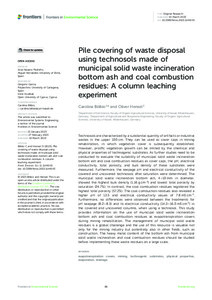| dc.date.accessioned | 2023-07-27T09:36:34Z | |
| dc.date.available | 2023-07-27T09:36:34Z | |
| dc.date.issued | 2023-03-10 | |
| dc.identifier | doi:10.17170/kobra-202307278504 | |
| dc.identifier.uri | http://hdl.handle.net/123456789/14934 | |
| dc.description.sponsorship | Gefördert durch den Publikationsfonds der Universität Kassel | |
| dc.language.iso | eng | |
| dc.rights | Namensnennung 4.0 International | * |
| dc.rights.uri | http://creativecommons.org/licenses/by/4.0/ | * |
| dc.subject | evapotranspiration covers | eng |
| dc.subject | mining | eng |
| dc.subject | technogenic substrates | eng |
| dc.subject | physical properties | eng |
| dc.subject | evaporation | eng |
| dc.subject | drainage | eng |
| dc.subject.ddc | 630 | |
| dc.title | Pile covering of waste disposal using technosols made of municipal solid waste incineration bottom ash and coal combustion residues: A column leaching experiment | eng |
| dc.type | Aufsatz | |
| dcterms.abstract | Technosols are characterized by a substantial quantity of artifacts or industrial wastes in the upper 100 cm. They can be used as cover caps in mining rehabilitation, in which vegetation cover is subsequently established. However, prolific vegetation growth can be limited by the chemical and physical properties of technogenic substrates. As further studies need to be conducted to evaluate the suitability of municipal solid waste incineration bottom ash and coal combustion residues as cover caps, the pH, electrical conductivity, total porosity, and bulk density of these substrates were measured. Furthermore, the seepage pH and electrical conductivity of the covered and uncovered technosols after saturation were determined. The municipal solid waste incineration bottom ash, 4–10 mm in diameter, showed the highest bulk density (1.16 g cm-³) and lowest total porosity by saturation (24.7%). In contrast, the coal combustion residues registered the highest total porosity (57.2%). The coal combustion residues also revealed a higher pH of 12.5 and electrical conductivity values of 7.8 mS cm-¹. Furthermore, no differences were observed between the treatments for pH seepage (8.2–8.3) and its electrical conductivity (14.3–16.0 mS cm-¹) in the covered and uncovered columns, when using a technosol. This study provides information on the use of municipal solid waste incineration bottom ash and coal combustion residues as evapotranspiration covers during mining rehabilitation. The management of municipal solid waste residues is a global challenge and the use of this resource is valuable not only for the mining industry but potentially also in other fields, such as construction. The heavy metal content of the bottom ash from municipal solid waste incineration and coal combustion residues should be studied before implementing these waste residues on a large scale. | eng |
| dcterms.accessRights | open access | |
| dcterms.creator | Bilibio, Carolina | |
| dcterms.creator | Hensel, Oliver | |
| dcterms.extent | 12 Seiten | |
| dc.relation.doi | doi:10.3389/fenvs.2023.1144043 | |
| dc.subject.swd | Evapotranspiration | ger |
| dc.subject.swd | Bergbau | ger |
| dc.subject.swd | Physikalische Eigenschaft | ger |
| dc.subject.swd | Entwässerung <Verfahrenstechnik> | ger |
| dc.subject.swd | Abfallbeseitigung | ger |
| dc.type.version | publishedVersion | |
| dcterms.source.identifier | eissn:2296-665X | |
| dcterms.source.journal | Frontiers in Environmental Science | eng |
| dcterms.source.volume | Volume 11 | |
| kup.iskup | false | |
| dcterms.source.articlenumber | 1144043 | |


